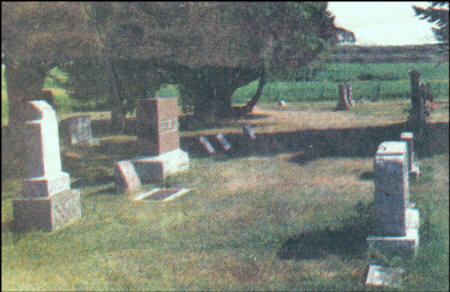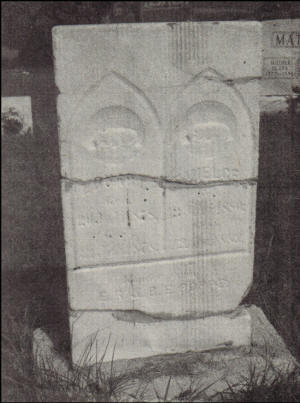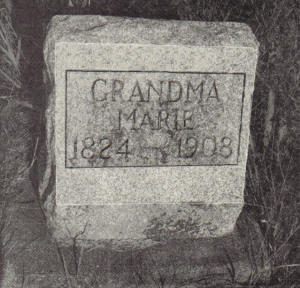Thorp Courier (Thorp, WI)
July 26, 2006, Front Page
Transcribed by
Dolores (Mohr) Kenyon.
Exploring Our Area’s Cemeteries
by Nancy Anderson

Resting
in the Peace of the Forest
Although no one alive today knows for certain
why settlers of the Town of Reseburg named their cemetery Sylvan, one can
speculate that they envisioned laying their loved ones to rest in a place
of peace, like a forest. According to local resident Ella Gorsegner,
the word "sylvan" is related to a woods or forest, and she's exactly correct.
According to a dictionary reference "sylvan" describes a countryside covered
with idyllic woods, and at the time of the association's inception, that
would have been an apt characterization of the area. Although today,
visitors look out over miles of farmland, the cemetery still carries that
peaceful, idyllic quality.
Way Back
to the Origins of Sylvan
Way back, when the first settlers were
beginning to populate Thorp and its surrounding countryside, land was primarily
in the possession of large lumber companies, hoping to make their fortunes in timber.
On May 29, 1879, Eau Claire Lumber Company vice-president Richard Schulenburg and
secretary, William A. Rush signed over land in the Town of Reseburg, south of what
ultimately became Thorp. Its new owners, at a cost of $200, were Herman Thiel
and his wife Abertine. The land was sold on April 28 of that year, along with
land in northerly Section 9, ‘”. . . hereby conveying only the soil of said land.”
The property’s pine timber, so the document said, was to be retained by the lumber
company, which maintained an easement allowing harvest for the next ten years.
Although cemeteries across the United
States dot the land with the name “Sylvan,” no one living today remembers the history
of why Reseburg’s cemetery took on that identification. The name “Sylvan”
fails to appear in records of Clark County or the surrounding area. Residents
today recall no stories about the association, wishing, as many of us do, that we’d
asked our ancestors more than we had when we were young. We can today only
speculate that the cemetery in the Town of Reseburg was named Sylvan due to the
word’s meaning: relating to woods or forest, an idyllic description of the countryside.
Less than four years after their purchase,
the Thiels turned land over to the Sylvan Cemetery Association for the purchase
price of $28.00, on Christmas—December 25, 1882. Effective February 5, 1883,
Justice of the peace J. J. Hayes presided over the transaction. Three short
months later, the Town of Reseburg was officially created by an ordinance of the
Clark County Board.
Back then, township organizers were
concerned with such necessities as creating a “mill tax of 7 on the dollar”, paying
the assessor and highway superintendent, and keeping hogs, bulls, and horses from
running at large on the highway. However, for others, the creation of the
Sylvan Cemetery was at the forefront of their minds.
Sylvan Cemetery records seem to document
at a young baby, Eduart Poppe, born July 20, 1878 and dying 11 days later, may have
been the cemetery’s first burial. Louis Reseburg was also an early burial
at the site. Records show that, born July 9, 1881, Louis died September 6,
1882. The infant graves, according to resident and Clerk for the Town of Reseburg,
Jackie Vetterkind, are primarily located in the cemetery’s northwest corner.
Its southwest corner was set aside for paupers’ graves, of which there are eight.
Other names soon followed: Laura S.
Biddle, infant daughter of Peter and Elizabeth (Wright) Biddle; Eleanor D. Casalez,
daughter of Elmer and Ada Vetterkind; several children of Wilhelm and Friederike
Goehring—most as new born; Anna Goregner, daughter of Christian Gorlieb and
Mary Gorsenger; the infant Emma Hansmann, daughter of August and Minnie Hansmann;
Kasten, Klaar, Mattes, Pagel, Poppe, and Roeseler—the little country cemetery on
County Highway N was quickly getting populated with the area’s loved ones.
Eventually William Colby, who fought as a Private in the Civil War and died May
17, 1920, and George W. Courter, Sr., with the Civil War infantry unit #27, Co.
B, laid to rest July 11, 1921, would join them.
Documents show that the cemetery association
was first formed November 10, 1883 and first recorded March 28 of the following
year. The first president of the cemetery association appears to be S. P.
Cook, with W. F. Goff serving as secretary and William Reseburg as treasurer.
Edith (Bradle) Godden was just four-and-a-half-
years old when in 1920 her family moved to the Town of Reseburg to take over her
grandfather’s farm. By then, the area was populated with successful operations,
albeit small by today’s standards. Edith remembers, “If you had a 120-acre
farm, you had a big farm. People often started out with a 40. Edith’s
parents lived a ways southwest of the Sylvan Cemetery.
Records jump ahead to a recorded entry
of the Sylvan Cemetery Association, which took place May 24, 1930. That July
5, the association reorganized, with names like Richard Coates, Herman Theil, and
John Barth listed as those responsible. Meetings were to be held the first
Monday of October of every year thereafter.
Association members also included Mrs.
Albert Burrington, Mrs. C. Butterfield, Lester Butterfield, Henry Coates, Gilbert
hardy, Charles Krause, Phillip Mattes, Arthur Meyers, Henry Rossman, John Thielke,
Emil Wilzien, and Henry Wilzien. Seven days after its reorganization, Charles
Krause was elected vide-president. A $2.00 annual lot fee was established for evry
eight graves, with purchasers able to pay a $1.00 fee for four lots.
Anita (Bobb) Nye, now of Newport, Minnesota,
grew up in the Town of Reseburg, as did the majority of her ancestors, and remembers
the area well. Her family came to the community in the late 1800’s, establishing
the Nye Lusk Hudson Sawmill, which provided the lumber for many of the homes being
constructed. Anita’s grandparents, Ida and Daniel Zimmer had their home near
what is now the Silver dollar corner, with Anita living close by. Anita’s
family eventually owned the Bobb Sawmill, also in the Town of Reseburg, about three
miles southeast of the Sylvan Cemetery. Anita is proud to say that all of
her great-grandparents are buried in the Sylvan Cemetery.
The Town of Reseburg took over responsibility
for the Sylvan Cemetery in the 1980’s, and in 1993-celebrated the town’s centennial.
At that time, local historians gathered together the township’s records, documenting
its legal doings as specifically as possible with little missing, except for a period
in the 1930’s when the town’s minutes book disappeared. V. Vetterkind says
that the last recorded burials at Sylvan were for Robert Palms and Leora Dudansky,
both in 2005. Today, all 91 lots, each having from four to eight graves, have
been purchased.
|
Sylvan Cemetery's Early
Memories
Eduart Poppe appears to be the
first person buried at the Sylvan Cemetery, dying as an infant
in 1878, son of Ernest R and Elizabeth Poppe. Another
early gravesite is that of Louis Reseburg, 1881-1882.
One of the more interesting headstones is that of "Grandma"
Welzien, 1824-1908, with no other first name marked to identify
her.
Although not actually associated
with the Sylvan Cemetery, the Lutheran Church was located nearby,
until it was moved into the City of Thorp in approximately 1948.
Neighbors still recall how power lines had to be temporarily
taken down along the highway for the structure's transport into
town.
|
Visit the Sylvan Cemetery



